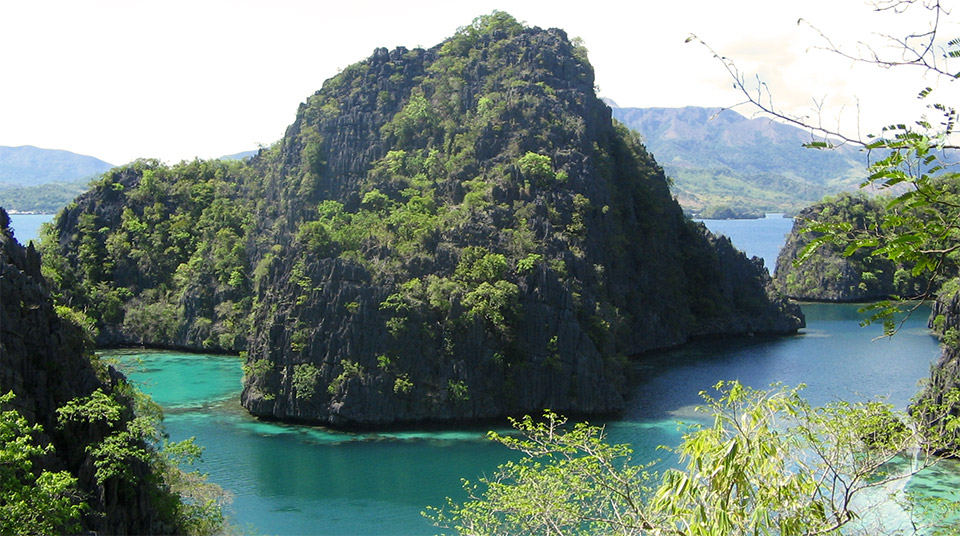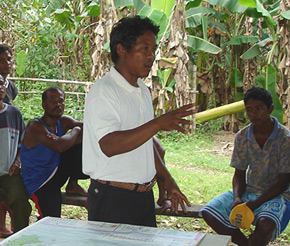Coron остров е клиновидна варовик остров, намира в юго-източната част на Busuanga остров във Филипините. По-голямата част от населението е Calamian Тагбануа, а имигрантите, идващи от Visayas район на страната са малцинство. Този архипелаг има различни типове екосистеми, като кораловите рифове, Seagrass, мангрови гори, лагуни със слабо солена и варовикови гори, които поддържат изключително биоразнообразие, хостинг висок процент на ендемизъм цветя и няколко редки видове риби като Blenny (Ecsenius създаване и Istiblennius Коул) и Dorryback (Labracinus atrofasciatus). Езера, намерени в земите на предците се считат за свещени от Calamian Тагбануа. , Е строго забранено да влиза в тях, освен ако не за културни цели, като например извършване на ритуали. Cabugao езеро, най-голямото езеро на острова, се счита за центъра на спиртни напитки.
Защитен на хартия, но застрашен в действителност.
Основните идентифицирани заплахи за тази област са:
- Ненадеждни споразумения за управление,
- Незаконни методи за риболов и последващо унищожаване на местни коралови рифове,
- Незаконна сеч,
- Преобразуване на горите в земеделски полета или обекти с различно предназначение на земята,
- Минното дело убива много местни хора, намаляване на работната сила за опазване на земите и водите,
- Модернизацията и имиграцията намаляват вярата и уважението към местните духове.
"Тагбанва бяха осигурили правата си върху земята нито миг по-рано. Остров Корон беше определен да бъде включен в Националната система за интегрирани защитени територии. Това, което Tagbanwa получи, бяха обещания за мажоритарно участие в управителния съвет на защитената зона. Tagband се съпротивляваше. Сега, след като е получил титла на родово владение над острова, Tagbanwa искат да запазят правата си върху земята и вземането на решения относно ресурсите, които ще засегнат бъдещето на острова." - Дейв де Вера, Изпълнителен директор на Филипинската асоциация за междукултурно развитие (PAFID).
Зрение
Ще е необходима по-силна опозиция, за да се изправи пред преобладаващите заплахи. Голямото предизвикателство сред старейшините е да съживят стриктното прилагане на обичайните правила като уважението към свещените места. Ще се нуждае от непрекъснато предаване на културни знания и практики, например под формата на сесии сред младежта. Освен това, поддържането на баланса с другите заинтересовани страни в региона ще предизвика Каламиан Тагбанва да бъде устойчив на бързите промени, които срещат.
Коалиция
Съветът на старейшините, Асоциацията на племето Tagbanwa и служителите на селото имат роли и отговорности за успешното управление на домейна на предците. Те се подкрепят от по-мащабни организации като Националната програма за интегрирани защитени територии, Филипинската асоциация за междукултурно развитие и Международният център на коренното население за политически изследвания и образование (ТЕБТЕББА).
Консервационни инструменти
Тези свещени води се съхраняват чрез изграждане на капацитет и укрепване на екологичното съзнание. Старейшините се обучават и подобряват знанията си по национални правни въпроси, така че да се научат как да предприемат стъпки срещу нарушителите. Междувременно, те се насърчават да организират сесии за трансфер на знания с местните младежи. Относно екологичното разбиране, организират се интерпретативни разходки по мангрова екосистема, докато се проучват варианти за риболов по по-устойчив начин.
Резултати
Освен статут на защитен регион, който е получил в различни организации, местните проучвания на участието дадоха резултати за повишаване на осведомеността и повишената културна организация сега помага за укрепване на културната идентичност и интегритет.
Попечители
Calamian Tagbanwa вярват, че духовете живеят в свещени езера. Тези езера са известни на местно ниво като паняан. Не всеки има право да посещава свещени места; хората трябва да имат определена цел, за да отидат там. Старейшини (мамаепет) и шамани (безплатно) играят основна роля при входа на свещена зона. Те произнасят ulliwatwat, молитва, която се обръща към духовете, за да поискат разрешение да влязат. До десетте паняана, които съществуват там, рибните резервати се считат за зони с ограничен достъп, където е забранен риболовът, пускане на котви, или за отглеждане на морски водорасли. Те вярват, че в района живее кунлалабют или гигантски октопод. Културните знания за такива явления се предават от по-възрастните на по-младите поколения чрез устна традиция.
Действие
В 1967, Остров Корон за първи път е обявен за национален резерват, след това по-късно в 1978 като туристическа зона и морски резерват и накрая му беше предоставено Споразумение за управление на Общността в 1990. В 1992, Остров Корон беше включен в приоритетните защитени територии по Националната програма за интегрирани защитени територии и стратегическия план за околната среда. В 1993, беше осигурено присъждане на сертификат за иск за наследствен домейн. В 1998, борбата на Каламиан Тагбанва да бъдат признати приключи, Остров Корон получи претенциите си за наследствен домейн от Министерството на околната среда и природните ресурси.
Политика и право
С приемането на Закона за правата на коренното население през 1997, местните народи в страната вече разполагат със система за подпомагане, която може да защити правата им върху техните наследствени владения. По наследство от предците, те сега притежават земите, и управлявайте над тях с отдавна установени закони. Но обичайните закони са неофициални, и старейшините отбелязват, че малцина са следвани. Основният проблем е, че няма обща визия за опазване на културното наследство: нарушителят има възможност да се подложи на закона Calamian Tagbanwa или националния закон.
- лак, A. (2010) Към устойчиво управление и омагьосана защита на свещените морски зони в родовия домейн на остров Корон на pawalan, в; Verschuuren, Див, McNeely и Овиедо, Свещени природни обекти; Съхраняване на природата и културата, Земята сканиране, Лондон.
- На Каламиан О, виждам; Етнолог, Езиците на света в: http://www.ethnologue.com/show_language.asp?code=tbk
- Филипинската асоциация за междукултурно развитие (PAFID) в: http://www.pafid.org.ph/
- Филипинската асоциация за междукултурно развитие и Международният център на коренното население за политически изследвания и образование (ТЕБТЕББА): http://tebtebba.org/





